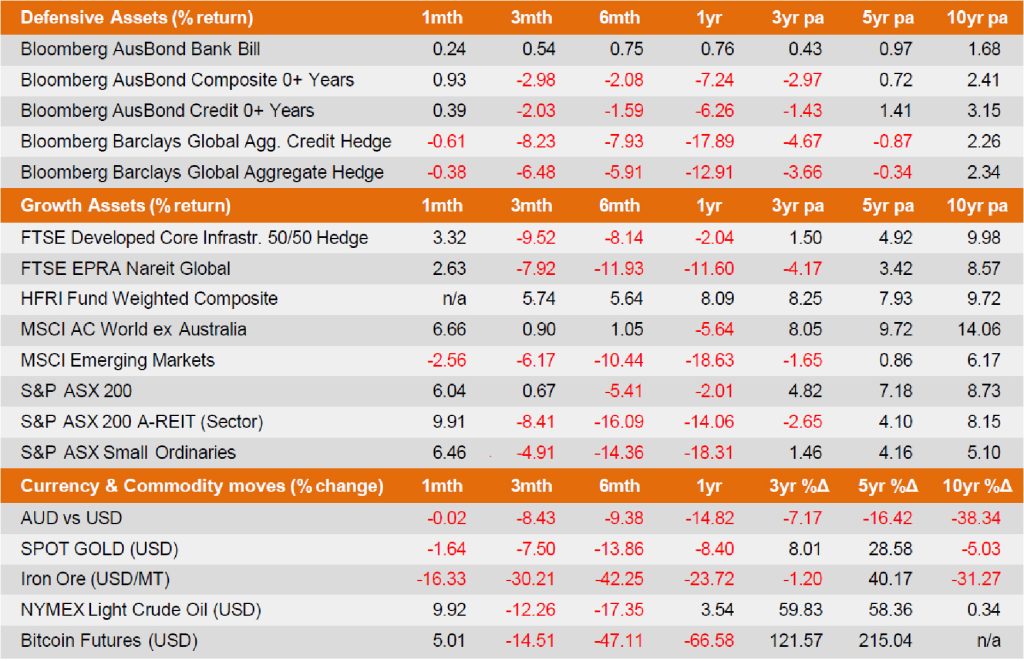Global share markets roared back in October, led by a 14% surge in the 30-stock Dow Jones index, capping off its best month since 1976. Meanwhile, the S&P 500 and tech-heavy Nasdaq added 8% and 3.9%, respectively. October’s gains came despite a mixed third-quarter earnings season, which showed slowing growth and major disappointments from large tech companies such as Meta Platforms (i.e., Facebook) and Amazon.
Closer to home, the ASX 200 returned just over 6% for the month for its strongest October performance since 2011 and delivered its largest monthly gain since March. The listed property sector and the Financials sector were the standout performers, returning 9.9% and 12.2%, respectively, as risk-free rates moved lower and investors bet that inflation was nearing a peak.
In Europe, annual inflation posted a double-digit rise and registered the highest ever monthly reading since the Eurozone’s formation. This seemed to justify recent interest rate hikes by the European Central Bank. However, concerns about stagflation intensified after Europe’s preliminary economic growth estimates came in barely above zero for October.
Elsewhere, crude oil prices staged a modest rebound, while iron ore prices continued to slump on waning demand from China. Its pursuit of zero-Covid policies and a collapse in property prices have stunted growth, with geopolitical concerns relating to Taiwan adding to uncertainty in the region.

Source: Evergreen Consultants, Financial Express, AUD total returns as at 31 October 2022.
A spectacular comeback by markets in October was highlighted by the US Dow Jones’ best ever performance in October of 13.95%, eclipsing the previous record of 10.65%. The ‘melt-up’ came despite meagre third-quarter 2022 earnings results that averaged low single digits and with money markets pricing yet another 0.75% hike to interest rates in November. The broader S&P 500 index also posted a strong month. However, over the course of the year US market returns have remained firmly in the red, with the key exception of the Energy sector, which has gained over 60%.
Trading in October was once again volatile and at one point US markets posted the fifth largest intraday reversal from a low in the history of the S&P 500, and the fourth largest for the Nasdaq. The moves followed the release of the September consumer price index, which came in higher than expected. Over the past three- and six-month periods, the MSCI AC World ex Australian index has delivered positive returns to local investors that are not currency hedged due to the significantly weaker Australian dollar. Domestic shares followed global markets higher during the month and even eked out a small positive return over the past three months, inclusive of dividends.
Domestic fixed interest enjoyed a strongly positive month as investors sought to re-establish positions in the traditionally defensive asset class, which was reflected in lower yields, especially at longer term maturities. However, offshore bond markets did not fare so well and again finished in the red. By the beginning of November, the US bond market was down 1.8% over the last six years, marking its largest decline in history over that particular multi-year period.
The key economic data release during the month seemed to be the US CPI, where both the headline and core (ex food and energy) printed well above expectations. Despite declines in energy prices, food and shelter jumped notably, with the latter helping the core CPI surge to a forty year high. The owners’ equivalent rent index posted its largest monthly increase in that index since June 1990. At the end of the month, the US Fed’s favoured measure of inflation – the core personal consumption expenditures (PCE) price index – printed in line with analyst expectations. On the activity front, the US economy returned to growth in the September quarter as GDP rose 0.6% but confirmed a deceleration in private domestic demand with the GDP increase driven by stronger net exports.
In Australia, the Reserve Bank (RBA) surprised markets with a smaller-than-expected increase in the official cash rate in October by 0.25%. The change to a less aggressive policy stance came as the RBA “assesses the outlook for inflation and economic growth in Australia”. Falling property prices finally appear to have caught the RBA’s attention. A few weeks later the September quarter CPI came in well above analyst expectations and now looks likely to finish 2022 at least 8% higher. This is above both the RBA’s forecast and Treasury’s updated prediction contained in the uneventful Labor Federal Budget that was handed down by Treasurer Jim Chalmers on October 25th.
Finally, October inflation reads in Germany and Italy surprised markets, easily beating expectations. The German CPI rose by 1.1% in the month as the energy crisis deepened. Not to be outdone, Italian consumer prices spiked by an extraordinary 4% in the month as utility bills continued to skyrocket.
Disclaimer: This economic and market update has been prepared by Evergreen Fund Managers Pty Ltd, trading as Evergreen Consultants, AFSL 486 275, ABN 75 602 703 202 and contains general advice only.
It is intended for Advisers use only and is not to be distributed to retail clients without the consent of Evergreen Consultants. Information contained within this update has been prepared as general advice only as it does not take into account any person’s investment objectives, financial situation or particular needs. The update is not intended to represent or be a substitute for specific financial, taxation or investment advice and should not be relied upon as such.
All assumptions and examples are based on current laws (as at June 2023) and the continuance of these laws and Evergreen Consultants’ interpretation of them. Evergreen Consultants does not undertake to notify its recipients of changes in the law or its interpretation. All examples are for illustration purposes only and may not apply to your circumstances.
Liability limited by a scheme approved under Professional Standards Legislation.